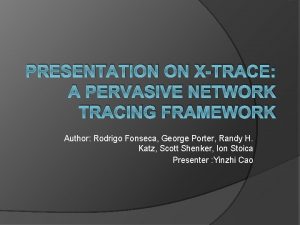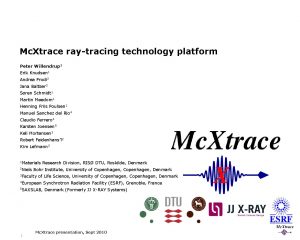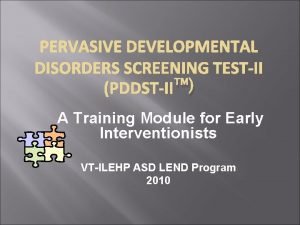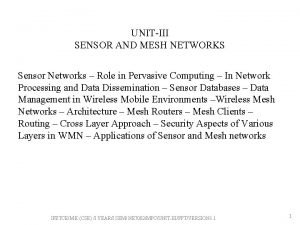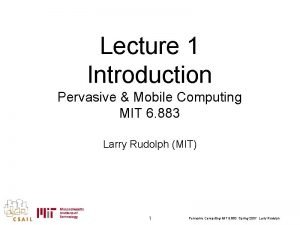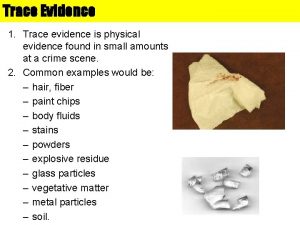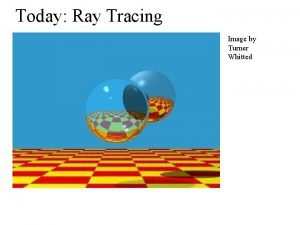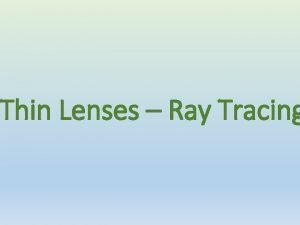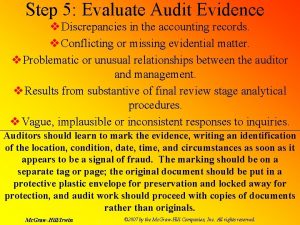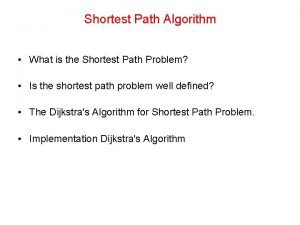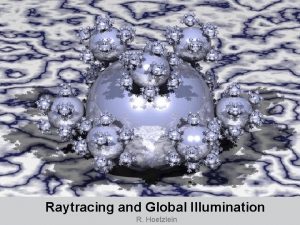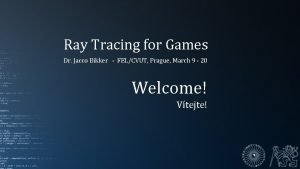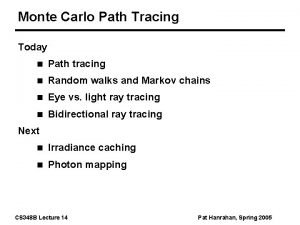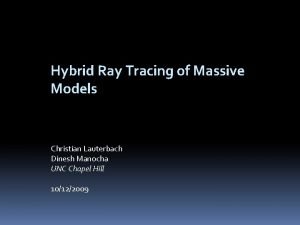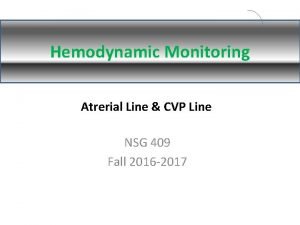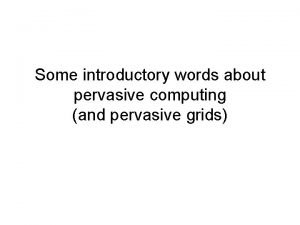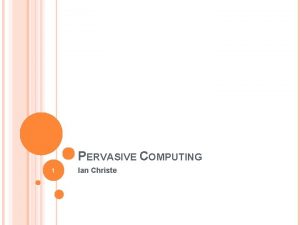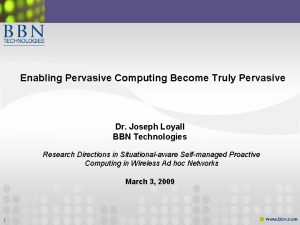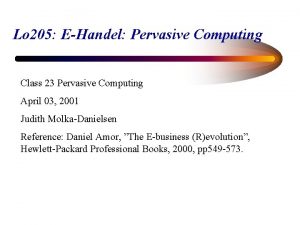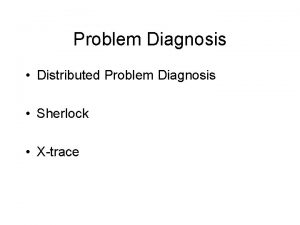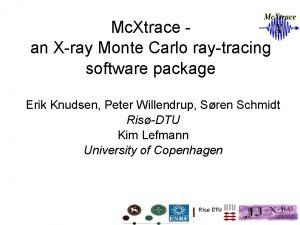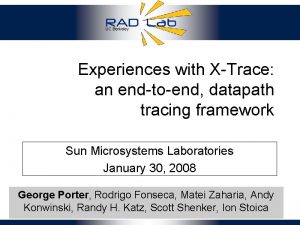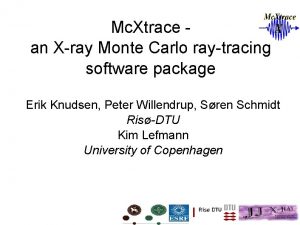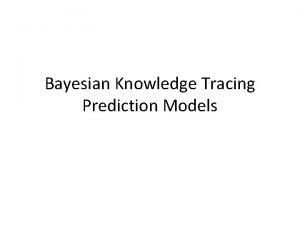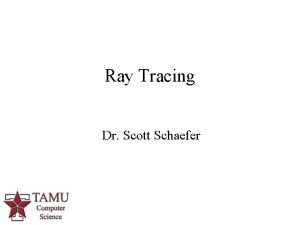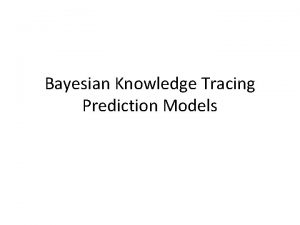PRESENTATION ON XTRACE A PERVASIVE NETWORK TRACING FRAMEWORK





































- Slides: 37

PRESENTATION ON X-TRACE: A PERVASIVE NETWORK TRACING FRAMEWORK Author: Rodrigo Fonseca, George Porter, Randy H. Katz, Scott Shenker, Ion Stoica Presenter : Yinzhi Cao

Outline � Background � Origin � X-Trace �Vector �Flowing Vector �God �Over. Head � Usage Scenarios � Potential Problems

Background(1) � Network Diagnosis � Scenarios One (Accessing Website)

Background(2) � Scenario Two (Distributed File System)

Background(3) Existing Method White Box X-Trace Black Box Wap 5 Sherlock Comparison of White Box and Black Box White. Box Black. Box Overhead Large Small Modification to Program Yes No Notification of Program No Yes Accuracy High Low

Origin of X-Trace How to Diagnosis a Person? 1. Radioactive Material Implies: We need a vector flowing in our body. 2. X-Ray Detector Implies: We need a collector to monitor activities. 3. Overhead Implies: There is no free lunch. �

X-Trace(Vector) � Vector: X-Trace Metadata

X-Trace(Flowing Vector) � Flowing Vector Only Vectors are of no use. We make it flow and we get the info. The following is an entity we want to diagnosis.

X-Trace(Flowing Vector) Continued � Let Vectors Flow. Two Ways: push. Next() and push. Down()

X-Trace(Collector) � Like diagnosing a person, we need a god to collect all the data and reconstruct offline trees. � The question is how to?

X-Trace(Overhead) � Modification of Existing Program

X-Trace(Overhead) Continued � Influence on Current Network Flow 1. Metadata is very small which brings little additional flow to the network. 2. Reports are sent in different channels which doesn’t occupy current network flow

Usage Scenarios of XTrace(1) � Web Request and Recursive DNS queries

Usage Scenarios of XTrace(2) �A Web Hosting Site

Usage Scenarios of XTrace(3) � An Overlay Network

Potential Problems Mentioned by Author � Report Loss � Managing Report Traffic � Non-Tree Request Structures � Partial Deployment � Security Consideration

We have examined White Box. So let’s come to some other approach, which may not be that accurate but may cost less overhead. First, we need some models.

PRESENTATION ON TOWARDS HIGHLY RELIABLE ENTERPRISE NETWORK SERVICES VIA INFERENCE OF MULTIAuthor: Victor Bahl, Ranveer Chandra, Albert LEVEL DEPENDENCIES Greenberg, Srikanth Kandula, David A. Maltz, Ming Zhang Presenter: Yinzhi Cao

Outline � Models �Node Model �Network Model �Relationship Model � How to use Our Model � Algorithm Efficiency � Evaluation

Models � The main idea of this paper is to establish a model of network and use this model to diagnose. � We have three levels of Model: Node, Network and Relationship.

Node Model � Node has three status: down, up and troubled.

Network Model � Graph � What’s more? Inference Graph.

Relationship Model(1) � Noisy-Max

Backup Slides 1 � First, we use the model below. The circle means with x probability the output is the input, and with 1 -x probability the output is up. � Let’s use unordered pair {x, y} to represent node status. {1, 1} = {1} up {0, 1} troubled {0, 0} = {0} down

Backup Slides 2 � So the status of Child can be represented as follows. Status(Child) = |Status(Parent) • Status(Parent)| • means outer product. And we define |(x, y)| = <x, y> = xy.

Relationship Model(2) � Selector

Relationship Model(3) � Failover

Backup Slides 3 � We use definition before. � Status(Parent 1)={x 1, x 2}, Status(Parent 2)={y 1, y 2}. � Status(Child)={(x 1+x 2)x 1+not(x 1+x 2)y 1, (x 1+x 2)x 2+not(x 1+x 2)y 2} + means and, * means or which is skipped.

How to Use Model? � Fault Localization on the Inference Graph

Algorithm Efficiency(1) � Calculations inside Inference Graph ( noisy max relationship ) � Reduce time complexity from O(3 n) to O(n)

Algorithm Efficiency(2) � Comparison of Multiple Input and Observation � Two Methods to Use 1. Examine Data Sets with High Probability and Ignore Small Ones 2. Dynamic Programming (Reduce Redundancy)

Algorithm Efficiency(3) Author conclude two observations using these two methods. 1. It is very likely that at any point in time only a few root-cause nodes are troubled or down. 2. Since a root-cause is assigned to be up in most assignment vectors, the evaluation of an assignment vector only requires reevaluation of states at the descendants of rootcause nodes that are not up. �

Evaluation � Inference Graph Established

Accuracy Compared with others

Time to Localize Faults

Impact of Errors in Inference Graph

Open Issues � The Node Model is very simple, which only has three status. Can we have a continuous model of it? � Can we take some stochastic process concept like Markov-Chain into this model?
 Image trace makes white box
Image trace makes white box Xtrace linux
Xtrace linux Money mangement international
Money mangement international Salesforce company overview
Salesforce company overview Primary and secondary stakeholders
Primary and secondary stakeholders Pervasive computing wikipedia
Pervasive computing wikipedia Pddst-ii
Pddst-ii Pervasive and mobile computing
Pervasive and mobile computing Pervasive computing ppt
Pervasive computing ppt Techy tipe now
Techy tipe now Pdd disorder
Pdd disorder Pervasive and mobile computing
Pervasive and mobile computing Pervasive mood
Pervasive mood Dispositional framework vs regulatory framework
Dispositional framework vs regulatory framework What is theoretical framework
What is theoretical framework Theoretical framework example
Theoretical framework example Conceptual framework theoretical framework
Conceptual framework theoretical framework Dispositional framework vs regulatory framework
Dispositional framework vs regulatory framework Conceptual framework vs theoretical framework
Conceptual framework vs theoretical framework Wavefront
Wavefront Pencil tracing of hull id number
Pencil tracing of hull id number Used to transfer marks from the pattern to the fabrics
Used to transfer marks from the pattern to the fabrics Steam tracing piping
Steam tracing piping Definition of trace evidence
Definition of trace evidence Turner whitted
Turner whitted Lens ray tracing
Lens ray tracing Tracing vs vouching
Tracing vs vouching Tracing dijkstra's algorithm
Tracing dijkstra's algorithm Rasterization vs ray tracing
Rasterization vs ray tracing Ray tracing actor
Ray tracing actor Perbedaan tracing dan vouching
Perbedaan tracing dan vouching Bidirectional path tracer
Bidirectional path tracer Eric veach thesis
Eric veach thesis Ffarcsi
Ffarcsi Dr c bravado fetal monitoring
Dr c bravado fetal monitoring Hybrid ray tracing
Hybrid ray tracing Square wave test arterial line
Square wave test arterial line Categories fetal heart tracing
Categories fetal heart tracing
